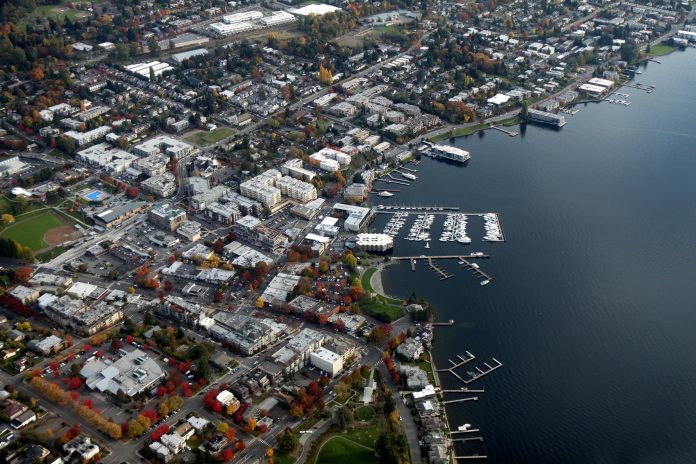On the Eastside, cities are grappling with the often competing desires to grow housing capacity and preserve tree canopy in urban areas. Tension between these goals is coming to a head in Kirkland, where the Master Builders’ Association of King and Snohomish Counties (MBAKS) is leading a case with the Growth Management Hearings Board to nullify the city’s newest tree codes. The new code, effective as of May 13, requires that increased care be given to preserve trees greater than 26 inches in diameter during redevelopment. Along with these “landmark trees,” developers would also be largely required to preserve tree groves, newly defined by the city as “three or more viable trees with overlapping or touching crowns.”
In a May 18 press release, MBAKS strongly condemned Kirkland’s action and described it as “a near total ban” on removal of landmark trees that would “hamper new home construction at a time when more housing supply is desperately needed.” Jennifer Anderson, Interim Government Affairs Director for MBAKS, alleged that a rushed process led to an outcome that unfairly burdens private property owners in reaching the city’s tree canopy goals. “Our core concern is that the tree ordinance, as adopted, places unreasonable burdens on homeowners and on the development of new housing… Extensive measures for tree retention are required under this code, with costs and time for retention adding up prohibitively quickly, resulting in less housing supply and attainability across diverse need,” Anderson explained in an email.
Importantly, Kirkland’s new tree ordinance does not mandate the preservation of trees “that would reduce maximum allowed density, number of allowed lots, maximum allowed Floor Area Ratio (FAR) or Lot Coverage, or preclude the ability to construct ADUs (accessory dwelling units) consistent with KZC 115.07…” In other words, developers would not be required to preserve landmark trees or tree groves that are impossible to preserve without reducing the development potential of a site. However, plaintiffs alleged in their filings that such a determination will be subject “solely [to] staff interpretation and opinion,” instead of to a list of objective criteria.
Work to update the city’s tree codes began in 2018, with an outreach process that included MBAKS, the Finn Hill Neighborhood Alliance (FHNA), and other stakeholders. MBAKS claims that the process was stopped during the pandemic, but that work from 2019 was picked back up in early 2022 with minimal time for stakeholders to provide their feedback. Countering these assertions, Katie Hogan, Environmental Program Coordinator in Kirkland’s Planning and Building Department, says that the outreach process for code amendments was never halted. “Because MBAKS and FHNA are important stakeholders but not necessarily representative of all community viewpoints, the City Council did not commit to adopting the group’s recommendations, only considering them, which they did,” according to Hogan.
Kirkland’s tree canopy has decreased from 40.7% in 2010 to 38.3% in 2017, and Hogan claims that the majority of this loss occurred in the single-family and short plat developments for which this ordinance would be in effect. However, Hogan noted that not all tree retention efforts are tied to private development and residential zones.
Through the city’s Parks Levy, Kirkland will seek to acquire additional lands that will “provide more land for tree protection and canopy enhancement,” according to Hogan. She also pointed to the Green Kirkland Partnership, a program to engage community members in the maintenance and remediation of 500 acres of municipal natural spaces, as further evidence of the city’s tree canopy efforts beyond single-family plots.
City staff do not see the new ordinance as particularly burdensome to growth, citing the provision around maximum allowed density. “The intent [of the ordinance] is that the applicant would have read the tree code and understood which trees are a priority for retention, design a plan around the regulations, and consult with City staff if clarification is needed, allowing the permit to be issued as compliant with tree retention standards (adding little cost for developers),” said Hogan.
Anderson presented a strikingly different picture, claiming that preservation efforts could result in an additional six month delay and over $100,000 in additional costs, including $20,000 for a new house plan. Although it’s unlikely that a separate, new house plan would be needed if developers were proceeding with the new tree codes in mind from the beginning of a project, ultimately the precise impacts on project length and cost remain unclear.
Equally unclear are the impacts this fight will have on neighboring jurisdictions. Over the last several months, Bellevue residents have flooded their City Council meetings to ask for stronger tree protections that still allow for the significant housing growth needed throughout the city. Bellevue has set a similar target of maintaining a 40% tree canopy coverage level for the city, but it has also underproduced new housing at nearly every level of affordability. An approach that takes a similar tactic to Kirkland’s, however, might also put Bellevue in legal jeopardy with developers.
For now, the case will advance before the Growth Management Hearings Board, with more information on schedule slated to come in the next few days. Regardless of the outcome, this case will certainly impact how Eastside cities choose to maintain their urban forest canopy.
Chris Randels is the founder and director of Complete Streets Bellevue, an advocacy organization looking to make it easier for people to get around Bellevue without a car. Chris lived in the Lake Hills neighborhood for nearly a decade and cares about reducing emissions and improving safety in the Eastside's largest city.


